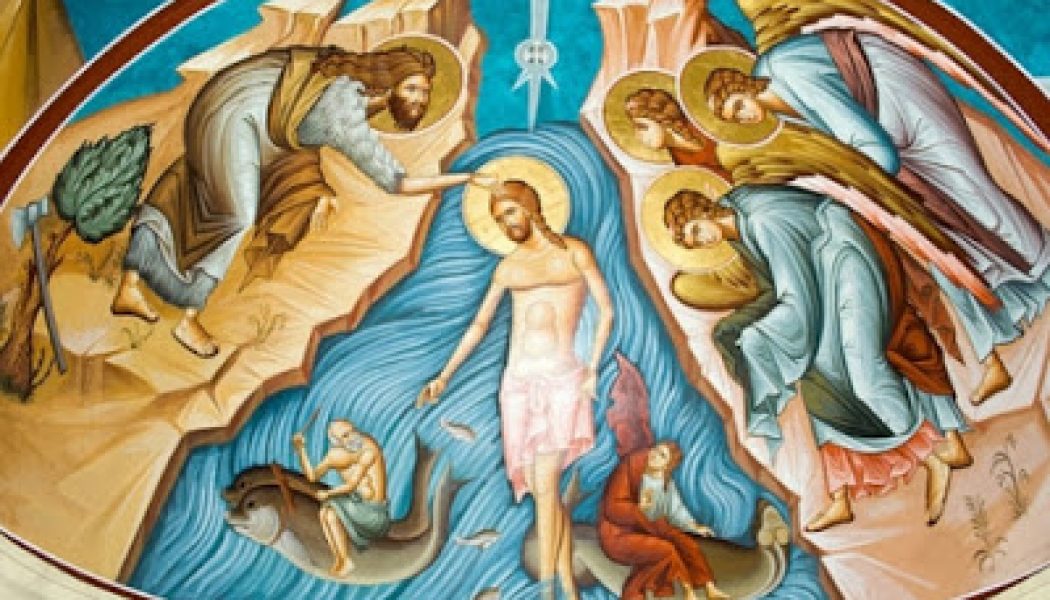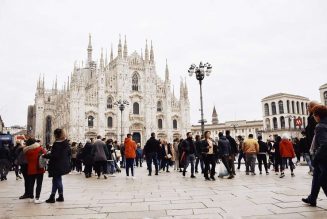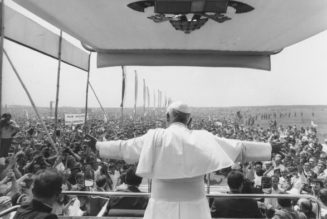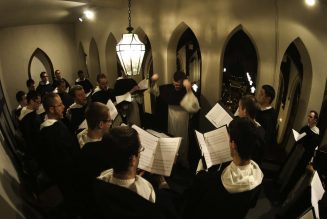Happy Feast of the Baptism! The celebration of the Lord’s baptism brings to a close the Christmas season. (In the extraordinary form calendar, the Christmas season continues till Feb. 2, the Feast of the Presentation. Thus, the custom of some of leaving their Christmas tree up until “Ground Hog Day.”) We are sad to leave behind the beautiful mysteries surrounding the birth of Our Lord on which we have been meditating for the past several weeks, but the tenderness of the childhood of the Lord must give way to the maturity of his manhood and the beginning of his public ministry. John the Baptist, that greatest of prophets and remarkable saint, has been accompanying us almost from the start of Advent, and makes a critical appearance once again in the Gospel for this feast. John plays the role of both priest and prophet as he mediates the washing and anointing of the King, the Son of David, in the waters of the Jordan. Traditionally, each new Son of David was washed and anointed before beginning his reign, so the Baptism in a sense marks the beginning of Jesus’ reign over his kingdom. Shortly afterwards, he will inaugurate his earthly ministry with the royal proclamation: “The kingdom of heaven is at hand!” (i.e. is here!).
1. Our First Reading is Isaiah 42:1-4, 6-7:
Thus says the LORD:
Here is my servant whom I uphold,
my chosen one with whom I am pleased,
upon whom I have put my spirit;
he shall bring forth justice to the nations,
not crying out, not shouting,
not making his voice heard in the street.
a bruised reed he shall not break,
and a smoldering wick he shall not quench,
until he establishes justice on the earth;
the coastlands will wait for his teaching.
I, the LORD, have called you for the victory of
justice,
justice,
I have grasped you by the hand;
I formed you, and set you
as a covenant of the people,
a light for the nations,
to open the eyes of the blind,
to bring out prisoners from confinement,
and from the dungeon, those who live in darkness.
This reading from Isaiah is a
portion of one of Isaiah’s famous “Servant Songs,” these long poems Isaiah
loved to compose which describe the mysterious “servant of the LORD” who is to
come and save Israel.
portion of one of Isaiah’s famous “Servant Songs,” these long poems Isaiah
loved to compose which describe the mysterious “servant of the LORD” who is to
come and save Israel.
This particular Servant Song
is very rich in imagery and theological content. I can’t deal with every motif and image
employed here, so I will focus on one: the royal motif.
is very rich in imagery and theological content. I can’t deal with every motif and image
employed here, so I will focus on one: the royal motif.
It is clear from the language
of Isaiah 42 that the “servant of the LORD” is a royal figure. Look at how he is described in the first
several verses: he is (1) the “servant” of God, (2) the “chosen one,” and (3)
the one anointed with the Spirit (“upon whom I have put my Spirit,” cf. Isa
61:1-2).
of Isaiah 42 that the “servant of the LORD” is a royal figure. Look at how he is described in the first
several verses: he is (1) the “servant” of God, (2) the “chosen one,” and (3)
the one anointed with the Spirit (“upon whom I have put my Spirit,” cf. Isa
61:1-2).
Now look at how David is
described in Psalm 89, perhaps the most important psalm about the Davidic
covenant in the entire Psalter:
described in Psalm 89, perhaps the most important psalm about the Davidic
covenant in the entire Psalter:
19 Of old thou didst speak in a vision to thy faithful
one, and say: “I have set the crown upon one who is mighty, I have exalted one chosen from the people. 20 I have found David, my servant; with my holy oil I have anointed him (Ps
89:19-20)
one, and say: “I have set the crown upon one who is mighty, I have exalted one chosen from the people. 20 I have found David, my servant; with my holy oil I have anointed him (Ps
89:19-20)
The point is, the figure
described in Isaiah 42:1-7 is a kingly figure, a royal person in the image and
likeness of David; in fact, the Son of David.
described in Isaiah 42:1-7 is a kingly figure, a royal person in the image and
likeness of David; in fact, the Son of David.
This theme continues in the
remainder of the reading. It is said
that the “servant” will bring forth justice to the nations, the earth, and the
coastlands. This is an allusion to the
ideal image of Solomon, the Son of David, who ruled an international empire,
was renowned for his brilliant application of justice in the court of law, and
taught justice to the nations through the wisdom literature (cf. 1 Kings 3-4,
10). The “bruised reed” and “smoldering
wick” are images of the oppressed, of people so poor and disadvantaged that
they are barely alive. In his
application of justice, this royal servant will not run roughshod over such
people, but will coax them back to life through his righteous
administration.
remainder of the reading. It is said
that the “servant” will bring forth justice to the nations, the earth, and the
coastlands. This is an allusion to the
ideal image of Solomon, the Son of David, who ruled an international empire,
was renowned for his brilliant application of justice in the court of law, and
taught justice to the nations through the wisdom literature (cf. 1 Kings 3-4,
10). The “bruised reed” and “smoldering
wick” are images of the oppressed, of people so poor and disadvantaged that
they are barely alive. In his
application of justice, this royal servant will not run roughshod over such
people, but will coax them back to life through his righteous
administration.
Later, the reading speaks of
the “servant” releasing the “blind,” the “imprisoned,” those in “dungeons” and
in “darkness.” These are all probably
references to the same group of people: those wrongly incarcerated by unjust
rulers who preceded the “servant” in royal office.
the “servant” releasing the “blind,” the “imprisoned,” those in “dungeons” and
in “darkness.” These are all probably
references to the same group of people: those wrongly incarcerated by unjust
rulers who preceded the “servant” in royal office.
So we note that there is a
heavy emphasis on the implementation of true justice as a role of the coming
servant. Moreover, the implementation of
justice was not primarily the role of the prophet or the priest, but of the
king. Thus, while it is not a matter of
“either/or,” we do observe that this reading focuses most on the royal dimension of the coming Servant.
heavy emphasis on the implementation of true justice as a role of the coming
servant. Moreover, the implementation of
justice was not primarily the role of the prophet or the priest, but of the
king. Thus, while it is not a matter of
“either/or,” we do observe that this reading focuses most on the royal dimension of the coming Servant.
Finally, we note one of the
most puzzling statements in this whole oracle, which comes near the end of our
selection:
most puzzling statements in this whole oracle, which comes near the end of our
selection:
I formed you, and set you
as a covenant of the people,
a light for the nations …
I slightly prefer the
rendering of the RSV, which says, “I have
given you as a covenant to the people, etc..” What is what puzzles: How can a person “be” a
covenant? It makes no sense. You can “make” a covenant between persons,
you can “mediate” a covenant, you can “write” down the stipulations of a
covenant, you can “renew” a covenant, but you can’t “become” a
covenant. What does Isaiah mean? How can the servant “become” a covenant for
the people, rather than “make” a covenant with them? It is difficult to make sense of this concept
if one is limited to the historical context of Isaiah’s own day. The meaning of this cryptic promise will only
become apparent in light of events much later in salvation history.
rendering of the RSV, which says, “I have
given you as a covenant to the people, etc..” What is what puzzles: How can a person “be” a
covenant? It makes no sense. You can “make” a covenant between persons,
you can “mediate” a covenant, you can “write” down the stipulations of a
covenant, you can “renew” a covenant, but you can’t “become” a
covenant. What does Isaiah mean? How can the servant “become” a covenant for
the people, rather than “make” a covenant with them? It is difficult to make sense of this concept
if one is limited to the historical context of Isaiah’s own day. The meaning of this cryptic promise will only
become apparent in light of events much later in salvation history.
We should also note that the
lines “a covenant of the people” and
“a light for the nations” are in
poetic parallelism in Hebrew, and should be understood as mutually illuminating
in terms of meaning. So it is not that
“he will be a light to the nations, but
not a light to the people, and he will be a covenant to the people but not to the nations,” but rather “he
will be light and covenant to both the people (Israel) and the nations
(Gentiles).” Therefore we have here an
oracle of the opening up of the covenant relationship with God to people of all
nationalities.
lines “a covenant of the people” and
“a light for the nations” are in
poetic parallelism in Hebrew, and should be understood as mutually illuminating
in terms of meaning. So it is not that
“he will be a light to the nations, but
not a light to the people, and he will be a covenant to the people but not to the nations,” but rather “he
will be light and covenant to both the people (Israel) and the nations
(Gentiles).” Therefore we have here an
oracle of the opening up of the covenant relationship with God to people of all
nationalities.
2. The Responsorial is Psalm 29:1-2, 3-4, 3,
9-10:
9-10:
R(11b)
The Lord will bless his people with peace.
The Lord will bless his people with peace.
Give to the LORD, you sons of God,
give to the LORD glory and praise,
Give to the LORD the glory due his name;
adore the LORD in holy attire.
R.
The Lord will bless his people with peace.
The Lord will bless his people with peace.
The voice of the LORD is over the waters,
the LORD, over vast waters.
The voice of the LORD is mighty;
the voice of the LORD is majestic.
R.
The Lord will bless his people with peace.
The Lord will bless his people with peace.
The God of glory thunders,
and in his temple all say, “Glory!”
The LORD is enthroned above the flood;
the LORD is enthroned as king forever.
R.
The Lord will bless his people with peace.
The Lord will bless his people with peace.
This Psalm is a doxology
praising the greatness of the LORD as “king forever” over the whole universe
(“enthroned above the flood”). In the
context of this Mass, this psalm is a praise of Christ the King who is revealed
in his Kingship at the Baptism, and rises from the waters of the Jordan to be “enthroned
above the flood.” We will expand on this
idea below.
praising the greatness of the LORD as “king forever” over the whole universe
(“enthroned above the flood”). In the
context of this Mass, this psalm is a praise of Christ the King who is revealed
in his Kingship at the Baptism, and rises from the waters of the Jordan to be “enthroned
above the flood.” We will expand on this
idea below.
3. The Second Reading is Acts 10:34-38:
Peter proceeded to speak to those gathered
in the house of Cornelius, saying:
“In truth, I see that God shows no partiality.
Rather, in every nation whoever fears him and acts
uprightly
uprightly
is acceptable to him.
You know the word that he sent to the Israelites
as he proclaimed peace through Jesus Christ, who is
Lord of all,
Lord of all,
what has happened all over Judea,
beginning in Galilee after the baptism
that John preached,
how God anointed Jesus of Nazareth
with the Holy Spirit and power.
He went about doing good
and healing all those oppressed by the devil,
for God was with him.”
This Reading from Acts
records a pivotal moment in the history of the world and human
civilization! In the context of Acts 10,
St. Peter is presiding over the first baptism of uncircumcised Gentile converts
to Christianity (Acts 10:47-48). This
was highly controversial in the early Church, because there was initial
disagreement among the apostles and elders of themselves over whether it was
appropriate to baptize Gentiles without first requiring them to be Jews (that
is, requiring circumcision: see Acts 15:1-35).
But here in Acts 10, Peter presides over the first such baptism of the
uncircumcised. Note how St. Luke, the
author of Acts, emphasizes Peter’s authority in the narratives that lead up to
Acts 10. We see Peter healing a
paralytic as Jesus did (Acts 9:32-35), and raising a woman from the dead as
Jesus did (Acts 9:36-43). This confirms
his authority to permit the baptism of the Gentiles and their entrance into the
Church, which was a fulfillment of our First Reading (“a covenant … and light
to the nations [or ‘Gentiles’]”), and a huge watershed in human history,
opening up the spread of the Gospel and the Church to ethnic groups in Europe,
Africa, and Asia, forever changing the history of cultures and nations, leading
to a day when (despite all difficulties) the whole world counts time by the
liturgical calendar of the Catholic Church (i.e. the Gregorian) and the birth
of Christ is one of the most universal and widely-celebrated international
holidays .
records a pivotal moment in the history of the world and human
civilization! In the context of Acts 10,
St. Peter is presiding over the first baptism of uncircumcised Gentile converts
to Christianity (Acts 10:47-48). This
was highly controversial in the early Church, because there was initial
disagreement among the apostles and elders of themselves over whether it was
appropriate to baptize Gentiles without first requiring them to be Jews (that
is, requiring circumcision: see Acts 15:1-35).
But here in Acts 10, Peter presides over the first such baptism of the
uncircumcised. Note how St. Luke, the
author of Acts, emphasizes Peter’s authority in the narratives that lead up to
Acts 10. We see Peter healing a
paralytic as Jesus did (Acts 9:32-35), and raising a woman from the dead as
Jesus did (Acts 9:36-43). This confirms
his authority to permit the baptism of the Gentiles and their entrance into the
Church, which was a fulfillment of our First Reading (“a covenant … and light
to the nations [or ‘Gentiles’]”), and a huge watershed in human history,
opening up the spread of the Gospel and the Church to ethnic groups in Europe,
Africa, and Asia, forever changing the history of cultures and nations, leading
to a day when (despite all difficulties) the whole world counts time by the
liturgical calendar of the Catholic Church (i.e. the Gregorian) and the birth
of Christ is one of the most universal and widely-celebrated international
holidays .
Our Second Reading records
the substance of Peter’s preaching on this occasion, which was a proclamation
of the ministry of Jesus Christ. St.
Luke sums up Peter’s account of Jesus’ earthly ministry like this:
the substance of Peter’s preaching on this occasion, which was a proclamation
of the ministry of Jesus Christ. St.
Luke sums up Peter’s account of Jesus’ earthly ministry like this:
beginning in Galilee after the baptism
that John preached,
how God anointed Jesus of Nazareth
with the Holy Spirit and power.
He went about doing good
and healing all those oppressed by the devil,
for God was with him.”
The Baptism of Jesus, which
began his earthly ministry, is identified here as “God anoint(ing) Jesus of
Nazareth with the Holy Spirit and power.”
This is a clue to us as to why Jesus was baptized. For Jesus, the baptism was not a washing with
sin, but an anointing with the Holy Spirit.
Didn’t Jesus have the Spirit before?
Of course, but it was an anointing “with the Holy Spirit and power,”
which should be taken as a hendiadys
indicating “a powerful anointing of the Holy Spirit” or “an anointing with the
Holy Spirit such as to release power.”
So the Baptism was an event in which God unleashed the power of the Holy
Spirit working through Jesus. The Spirit
and the Son join in mission to “do good and heal all those oppressed by the
devil.” Those oppressed by the devil,
whether caught in the chains of sinful habits or even outright possession, are
the ones to whom Isaiah referred when he said the Servant would “bring out prisoners from confinement, and
from the dungeon, those who live in darkness.”
The spiritual imprisonment of a life of sin is far greater than the
physical confinement of incarceration.
In fact, there are some who essentially imprison their bodies in order
to gain spiritual freedom: cloistered monks and nuns. Physically, their lives resemble those of
prisoners! Yet in spiritual freedom they
surpass many in joy.
began his earthly ministry, is identified here as “God anoint(ing) Jesus of
Nazareth with the Holy Spirit and power.”
This is a clue to us as to why Jesus was baptized. For Jesus, the baptism was not a washing with
sin, but an anointing with the Holy Spirit.
Didn’t Jesus have the Spirit before?
Of course, but it was an anointing “with the Holy Spirit and power,”
which should be taken as a hendiadys
indicating “a powerful anointing of the Holy Spirit” or “an anointing with the
Holy Spirit such as to release power.”
So the Baptism was an event in which God unleashed the power of the Holy
Spirit working through Jesus. The Spirit
and the Son join in mission to “do good and heal all those oppressed by the
devil.” Those oppressed by the devil,
whether caught in the chains of sinful habits or even outright possession, are
the ones to whom Isaiah referred when he said the Servant would “bring out prisoners from confinement, and
from the dungeon, those who live in darkness.”
The spiritual imprisonment of a life of sin is far greater than the
physical confinement of incarceration.
In fact, there are some who essentially imprison their bodies in order
to gain spiritual freedom: cloistered monks and nuns. Physically, their lives resemble those of
prisoners! Yet in spiritual freedom they
surpass many in joy.
4. The Gospel is Matt 3:13-17:
Jesus came from Galilee to John at the Jordan
to be baptized by him.
John tried to prevent him, saying,
“I need to be baptized by you,
and yet you are coming to me?”
Jesus said to him in reply,
“Allow it now, for thus it is fitting for us
to fulfill all righteousness.”
Then he allowed him.
After Jesus was baptized,
he came up from the water and behold,
the heavens were opened for him,
and he saw the Spirit of God descending like a dove
and coming upon him.
And a voice came from the heavens, saying,
“This is my beloved Son, with whom I am well pleased.”
Knowing that one of the
primary reasons for baptism was to publicly signify one’s repentance from sin,
and that Jesus had no sin from which to repent, John objects to Jesus’ baptism:
“I need to be baptized by you, yet you are coming to me?”
primary reasons for baptism was to publicly signify one’s repentance from sin,
and that Jesus had no sin from which to repent, John objects to Jesus’ baptism:
“I need to be baptized by you, yet you are coming to me?”
But repentance from sin is only
one significance of baptism. There are
others equally or more important.
one significance of baptism. There are
others equally or more important.
In the Old Testament, we see
that when the Son of David replaced his father as king over Israel, we was
taken to sacred water, anointed, and then began his reign. First Kings 1:32-40 records this ritual for
us. When he became king, Solomon was
taken to the Gihon, the spring that served as the only fresh water source for
all Jerusalem. The Gihon (Heb. “gusher”)
was named after one of the rivers of Eden, because it Jerusalem was regarded as
a mystical New Eden where one could “walk with God” in the Temple. So the Gihon spring was rich in symbolism: a
source of sacred water, it recalled the life-giving waters of God’s good
creation, before the Fall, in the Garden.
Now, 1 Kings 1 does not specifically say what they did to Solomon at the
Gihon, but there was no point in taking him there unless they were going to
wash him and/or have him drink, and based on ancient Near Eastern parallels as
well as other biblical texts, we may be confident that Solomon both washed and
drank from the Gihon, and then received the anointing from Zadok, the acting
High Priest, and Nathan, the ranking prophet (1 Kings 1:45).
that when the Son of David replaced his father as king over Israel, we was
taken to sacred water, anointed, and then began his reign. First Kings 1:32-40 records this ritual for
us. When he became king, Solomon was
taken to the Gihon, the spring that served as the only fresh water source for
all Jerusalem. The Gihon (Heb. “gusher”)
was named after one of the rivers of Eden, because it Jerusalem was regarded as
a mystical New Eden where one could “walk with God” in the Temple. So the Gihon spring was rich in symbolism: a
source of sacred water, it recalled the life-giving waters of God’s good
creation, before the Fall, in the Garden.
Now, 1 Kings 1 does not specifically say what they did to Solomon at the
Gihon, but there was no point in taking him there unless they were going to
wash him and/or have him drink, and based on ancient Near Eastern parallels as
well as other biblical texts, we may be confident that Solomon both washed and
drank from the Gihon, and then received the anointing from Zadok, the acting
High Priest, and Nathan, the ranking prophet (1 Kings 1:45).
So we observe this parallel
between Jesus and Solomon: like Solomon, Jesus is taken to a source of sacred
water (in this case, the Jordan, rich in salvation-historical symbolism) and
there washed and anointed by the ranking priest and prophet. John the Baptist stands in for both roles,
since he was clearly the ranking prophet of his day, and moreover was of
priestly blood through his father Zechariah (Luke 1:5).
between Jesus and Solomon: like Solomon, Jesus is taken to a source of sacred
water (in this case, the Jordan, rich in salvation-historical symbolism) and
there washed and anointed by the ranking priest and prophet. John the Baptist stands in for both roles,
since he was clearly the ranking prophet of his day, and moreover was of
priestly blood through his father Zechariah (Luke 1:5).
This leads us to an answer to
our initial question: Why was Jesus baptized?
Not as a washing away of his sin, but “in order to fulfill all
righteousness,” which means, among other things, to fulfill the
Scriptures. And the prophetic meaning of
Solomon’s washing and anointing to begin his reign (1 Kings 1:32-40) had to be
fulfilled in the One who was greater than Solomon (Matt 12:42).
our initial question: Why was Jesus baptized?
Not as a washing away of his sin, but “in order to fulfill all
righteousness,” which means, among other things, to fulfill the
Scriptures. And the prophetic meaning of
Solomon’s washing and anointing to begin his reign (1 Kings 1:32-40) had to be
fulfilled in the One who was greater than Solomon (Matt 12:42).
For Jesus, baptism means
something different than it does for us.
For Jesus, his baptism represents his ritual anointing in order to begin
his kingly reign. This is why the voice
of God the Father booms from heaven, saying “This is my beloved Son, in whom I
am well pleased.” The Father’s voice
echoes, among other texts, Psalm 2 (see v. 7), which was probably the Royal
Coronation Hymn of the ancient Kingdom of David. They may have sung Psalm 2 first for Solomon
when he ascended the throne of his father David, after the events of 1 Kings
1:32-40. Psalm 2:7-8 as a part that was
probably recited or chanted by the newly-enthroned king:
something different than it does for us.
For Jesus, his baptism represents his ritual anointing in order to begin
his kingly reign. This is why the voice
of God the Father booms from heaven, saying “This is my beloved Son, in whom I
am well pleased.” The Father’s voice
echoes, among other texts, Psalm 2 (see v. 7), which was probably the Royal
Coronation Hymn of the ancient Kingdom of David. They may have sung Psalm 2 first for Solomon
when he ascended the throne of his father David, after the events of 1 Kings
1:32-40. Psalm 2:7-8 as a part that was
probably recited or chanted by the newly-enthroned king:
“I
will tell of the decree of the LORD: He said to me, ‘You are my son, today I
have begotten you. Ask of me, and I will
make the nations your heritage, and the ends of the earth your possession.’”
(Psalm 2:7-8)
will tell of the decree of the LORD: He said to me, ‘You are my son, today I
have begotten you. Ask of me, and I will
make the nations your heritage, and the ends of the earth your possession.’”
(Psalm 2:7-8)
So we observe how the
extension of the reign of the Son of David over the nations, already seen in
previous readings, recurs here.
extension of the reign of the Son of David over the nations, already seen in
previous readings, recurs here.
After the baptism (and his
prayer-sojourn in the desert), Jesus begins to travel through Israel
proclaiming, “Repent, for the kingdom of heaven is at hand.” (Matt 4:17). The “kingdom of God is at hand” because
Jesus, the King, has been anointed and begun his earthly reign. One of the most prominent signs that his
reign has begun is the practice of exorcism, which shows that the pretended
“ruler of the world” (Satan) has been defeated, and now Jesus is in
charge. The exorcisms fulfill Isaiah’s
promise that the servant “upon whom I have put my Spirit” will lead prisoners
out of captivity.
prayer-sojourn in the desert), Jesus begins to travel through Israel
proclaiming, “Repent, for the kingdom of heaven is at hand.” (Matt 4:17). The “kingdom of God is at hand” because
Jesus, the King, has been anointed and begun his earthly reign. One of the most prominent signs that his
reign has begun is the practice of exorcism, which shows that the pretended
“ruler of the world” (Satan) has been defeated, and now Jesus is in
charge. The exorcisms fulfill Isaiah’s
promise that the servant “upon whom I have put my Spirit” will lead prisoners
out of captivity.
Did I say that Jesus’ baptism
means something different than it does for us?
Not quite. Our baptism also marks
our washing, anointing, and accession to the throne. We begin our kingly reign when we are
baptized. In our baptism, we are
anointed with the Holy Spirit, receive power over the devil, and are
strengthened to “do good and heal those oppressed by the devil.” We heal them through prayer, proclaiming the
good news, and taking them to receive the sacraments, especially baptism and
confession, which have exorcistic power.
means something different than it does for us?
Not quite. Our baptism also marks
our washing, anointing, and accession to the throne. We begin our kingly reign when we are
baptized. In our baptism, we are
anointed with the Holy Spirit, receive power over the devil, and are
strengthened to “do good and heal those oppressed by the devil.” We heal them through prayer, proclaiming the
good news, and taking them to receive the sacraments, especially baptism and
confession, which have exorcistic power.
Some of the finest exorcists
in the Church today have said that a good confession is better than an
exorcism. Struggling with sin and
spiritual warfare? A good application of
the message of the Readings this week would be to take advantage of the “second
Baptism” that we call the Sacrament of Reconciliation. In this sacrament, Jesus shows forth his
royal power by driving out sin and the devil in our lives. Make plans to make a good, thorough
confession this week, to strengthen yourself in your own kingly reign over sin
and Satan.
in the Church today have said that a good confession is better than an
exorcism. Struggling with sin and
spiritual warfare? A good application of
the message of the Readings this week would be to take advantage of the “second
Baptism” that we call the Sacrament of Reconciliation. In this sacrament, Jesus shows forth his
royal power by driving out sin and the devil in our lives. Make plans to make a good, thorough
confession this week, to strengthen yourself in your own kingly reign over sin
and Satan.
In the Mass at which these
readings are read, Jesus himself will later appear in person, under the forms
of bread and wine. These forms, his very
Body and Blood, will be declared to be the “New and Everlasting Covenant.” Then the priest will over His Body and Blood
to all who have been baptized into him. In this way, the Servant himself will
be “given as a covenant to the people,”
in order that those “who live in darkness”
may be brought out of confinement. And
so all Isaiah’s words find their fulfillment in Him. In this mass and every mass,
we experience the fulfillment of the Scriptures by our participation in the
Sacrament.
readings are read, Jesus himself will later appear in person, under the forms
of bread and wine. These forms, his very
Body and Blood, will be declared to be the “New and Everlasting Covenant.” Then the priest will over His Body and Blood
to all who have been baptized into him. In this way, the Servant himself will
be “given as a covenant to the people,”
in order that those “who live in darkness”
may be brought out of confinement. And
so all Isaiah’s words find their fulfillment in Him. In this mass and every mass,
we experience the fulfillment of the Scriptures by our participation in the
Sacrament.








